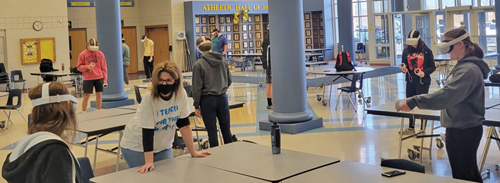Independence and Nordonia students experience math through virtual reality
by Sara Hill
No other employment sector is more forward thinking than education, where interactive whiteboards have replaced one-dimensional blackboards, touch screens have rendered chalk and erasers useless, and virtual platforms have turned traditional learning on its head.
And students, thanks to their progressive school leaders, are embracing new technologies like never before.
“It was kind of like witnessing a zombie apocalypse,” said Mike Pennington, Independence Local Schools’ director of curriculum and technology integration, after watching high school math students use new virtual reality Oculus headsets in their algebra classes. “I walked in, and the students were absolutely quiet and moving slowly around the room with their hands outstretched.”
Independence and Nordonia Hills have been chosen, along with a handful of other districts in the state, to be part of a beta study testing out virtual reality learning modules designed by California company Prisms. Data gathered from the study is being analyzed by WestEd, a research, development and service agency. The technology was brought in following a presentation by Prisms at a regional superintendents meeting.
The algebra module, aptly named, “Pandemic: How can we save our city’s hospitals?” has students explore the mathematics of a viral outbreak, while a geometry-based program has users create a gondola system to connect two snowy villages following a failure in the power grid.
“For any teacher, being able to take your standards and make them relevant to students is absolutely key,” Pennington said. “Really, we’re competing with the technology young people have in their lives already. Our consumers – students – demand more, and the algebra outbreak module is really relevant and has students using math to understand things happening right now in our society.”
Todd Stuart, director of curriculum and instruction for Nordonia Hills City School District, said the virtual reality technology helps algebra students learn firsthand through experimenting, personalized learning and data analysis. There are different lessons for certain areas of standards, including spatial reasoning, linear functions, quadratics, exponentials, systems of equations and statistics.
Students use headsets and hand controls and are completely immersed in a mathematical virtual world where game characters interact with them, every sense is utilized and failure is necessary to succeed. Needless to say, it’s quite different from math lessons of the not-so-distant past.
“We have to prepare students for their future, not our past,” Pennington said, referring to a quote by famed educational reform leader John Dewey. “The world our kids are going into is not the world we grew up in.”
“The students pick up on it very quickly,” Stuart said of the Oculus headsets. “They are learning mathematical concepts in a totally different realm, in a different way.”
Virtual reality learning modules could trickle into more subject matters and disciplines as Nordonia already uses the technology in social studies. Time, and data, will tell if virtual reality goggles replace looking at a teacher in the front of a physical classroom. ∞

